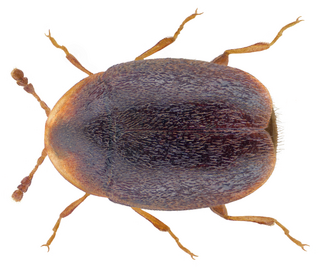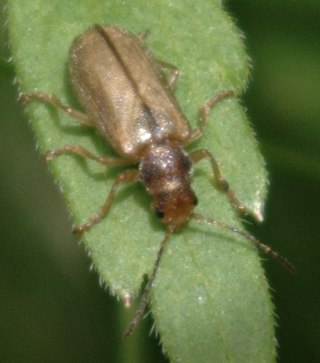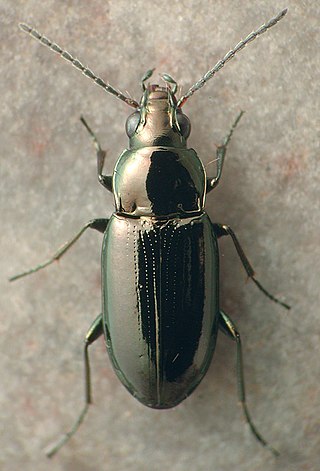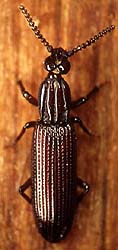
Ground beetles are a large, cosmopolitan family of beetles, the Carabidae, with more than 40,000 species worldwide, around 2,000 of which are found in North America and 2,700 in Europe. As of 2015, it is one of the 10 most species-rich animal families. They belong to the Adephaga. Members of the family are primarily carnivorous, but some members are herbivorous or omnivorous.

The Hydroscaphidae are a small family of water beetles known commonly as skiff beetles. As of 2010, there are 23 species in the family. Several are recently described.

The Adephaga are a suborder of beetles, and with more than 40,000 recorded species in 10 families, the second-largest of the four beetle suborders. Members of this suborder are collectively known as adephagans. The largest family is Carabidae which comprises most of the suborder with over 40,000 species. Adephaga also includes a variety of aquatic beetles, such as predaceous diving beetles and whirligig beetles.

Amphizoa is a genus of aquatic beetles in the suborder Adephaga, placed in its own monogeneric family, Amphizoidae. There are five known species of Amphizoa, three in western North America and two in the eastern Palearctic. They are sometimes referred to by the common name troutstream beetles.

Myxophaga is the second-smallest suborder of the Coleoptera after Archostemata, consisting of roughly 65 species of small to minute beetles in four families. The members of this suborder are aquatic and semiaquatic, and feed on algae.

Jurodidae is a family of beetles that was originally described for the extinct genus Jurodes, known from the Middle-Late Jurassic of Asia. In 1996, a living species, Sikhotealinia zhiltzovae was discovered in the Sikhote-Alin mountains in southeastern Siberia, and assigned to this family. Their placement is uncertain, but are usually considered archostematans. In one study, Sikhotealinia and Jurodes were considered a sister group to all other archostematan beetles. However, other authors have considered their placement within beetles as a whole uncertain, due to their mix characteristics of typical Archostemata, as well as Polyphaga and Adephaga.

Corylophidae is a family of minute hooded beetles, sometimes called minute fungus beetles, in the superfamily Coccinelloidea. There are about 18 genera and at least 120 described species in Corylophidae. They feed on microfungi such as molds, and are often found associated with bark, as well as in leaf litter and other decaying vegetation. In older literature, the family name was often given as Orthoperidae.

The Synetinae are a small subfamily within the leaf beetle family (Chrysomelidae). They are found entirely within the Holarctic, mainly in North America but also appearing in parts of Europe and Asia. The subfamily contains only two genera, Syneta and Thricolema, with a total of 12 described species. The group is sometimes treated as a tribe of Eumolpinae, where they are known as Synetini.
Rhysodinae is a subfamily in the family Carabidae. There are 19 genera and at least 380 described species in Rhysodinae. The group of genera making up Rhysodinae had been treated as the family Rhysodidae in the past, and subsequent DNA analysis then placed it within Carabidae, where it was sometimes treated as the tribe Rhysodini, but the most recent analyses place it as a subfamily in a clade along with subfamilies Paussinae and Siagoninae, forming a sister to the remaining Carabidae.

Omoglymmius is a genus in the ground beetle subfamily Rhysodinae. There are more than 150 described species in Omoglymmius, found on every continent except Antarctica.

Omoglymmius germari is a species of beetle in the subfamily Rhysodidae. It was described by Ludwig Ganglbauer in 1891. It is located in Central and South Europe and can be found in deciduous forests, living in old fallen trunks of trees. As they rely on decaying wood at some point in their lifespan, they are saproxylic beetles.
Clinidium calcaratum is a species of ground beetle in the subfamily Rhysodinae. It was described by John Lawrence LeConte in 1875. It is known from the western North America between California and British Columbia.

Ross Taylor Bell was an American entomologist with particular interest in the invertebrate natural history of Vermont, United States, and carabid beetles. Together with his wife, Joyce Rockenbach Bell, his work at the University of Vermont was largely taxonomic, where they described more than 75% of the rhysodine species known to science. Ross also wrote a number of seminal papers in his chosen field.
Aspidytes is a genus of aquatic beetles in the family Aspidytidae, first recorded in 2002 from specimens in South Africa. The genus contains the single species Aspidytes niobe. Originally a second species from China was placed in the same genus but has later been transferred to Sinaspidytes. The aquatic beetle is 6.5 - 7.2 mm long and lives in hygropetric habitats.
Bembidion salebratum is a species of beetle in the family Carabidae. It is found in Canada and the United States.

Bembidion nitidum is a species of beetle in the family Carabidae. It is found in Canada and the United States.

Bembidion tigrinum is a species of ground beetle in the family Carabidae. It is found in North America.

Aspidytidae is a family of aquatic beetles of the suborder Adephaga, described in 2002 from specimens in South Africa and China. There are only two known species in the family and these were originally described in the genus Aspidytes, but later the new genus Sinaspidytes was erected for the species found in China. The family can also be referred to by its trivial name cliff water beetles.

Sinaspidytes is a genus of aquatic beetles in Aspidytidae, first recorded in 2003 from specimens in the Shaanxi province, China. It is monotypic, with the only species being Sinaspidytes wrasei. Originally this species was placed in the genus Aspidytes with a second species from South Africa, but was later transferred to Sinaspidytes. The genus contains the single species S. wrasei. The aquatic beetle is 4.8 - 5.2 mm long and lives in hygropetric habitats.














